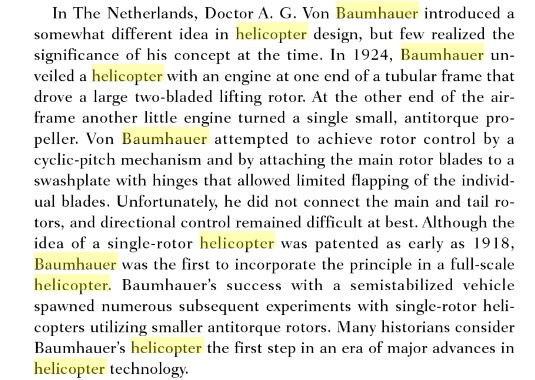Nice find
hesham!
This is a compound-helicopter derivative of Albert Gillis von Baumhauer's 'conventional' helicopter of 1924. An obvious difference - aside from the biplane wings, obviously - is the use of an inline main engine. The 1924 helicopter had a radial in this position. Part of the downfall of von Baumhauer's helicopter designs was that they required a second engine to drive the torque-eliminating tail rotor.
Another unbuilt von Baumhauer project was his early '30s
Helicoptère-vliegtuig (Helicopter-aircraft) with which he hoped to test lifting rotors in both fast- and slow-speed flight. The
Helicoptère-vliegtuig was originally to have contra-rotating rotors (a return to von Baumhauer's 1910 model helicopter) but seems - appropriate to your find - to have evolved into a compound helicopter concept.
BTW, the 1924 helicopter had a single, teetering main-rotor but proved a poor flier (capable of making only short hops). It was destroyed in a crash on 29 August 1930 but von Baumhauer was unharmed. He was less lucky on 18 March 1939. While in the US on behalf the Luchtvaartdienst, von Baumhauer was killed in the crash of the Boeing Stratoliner prototype.
For von Baumhauer's connections with other helicopter pioneers, see
The Transmission of Helicopter Technology, 1920–1939: Exchanges with von Baumhauer by Alex de Voogt.
Alex de Voogt also delivered a paper,
Helicopter History: The implications of the von Baumhauer at the 33rd European Rotorcraft Forum at Kazan in 2007.
For personal background, see:
http://resources.huygens.knaw.nl/bwn1880-2000/lemmata/bwn3/baumhauer























